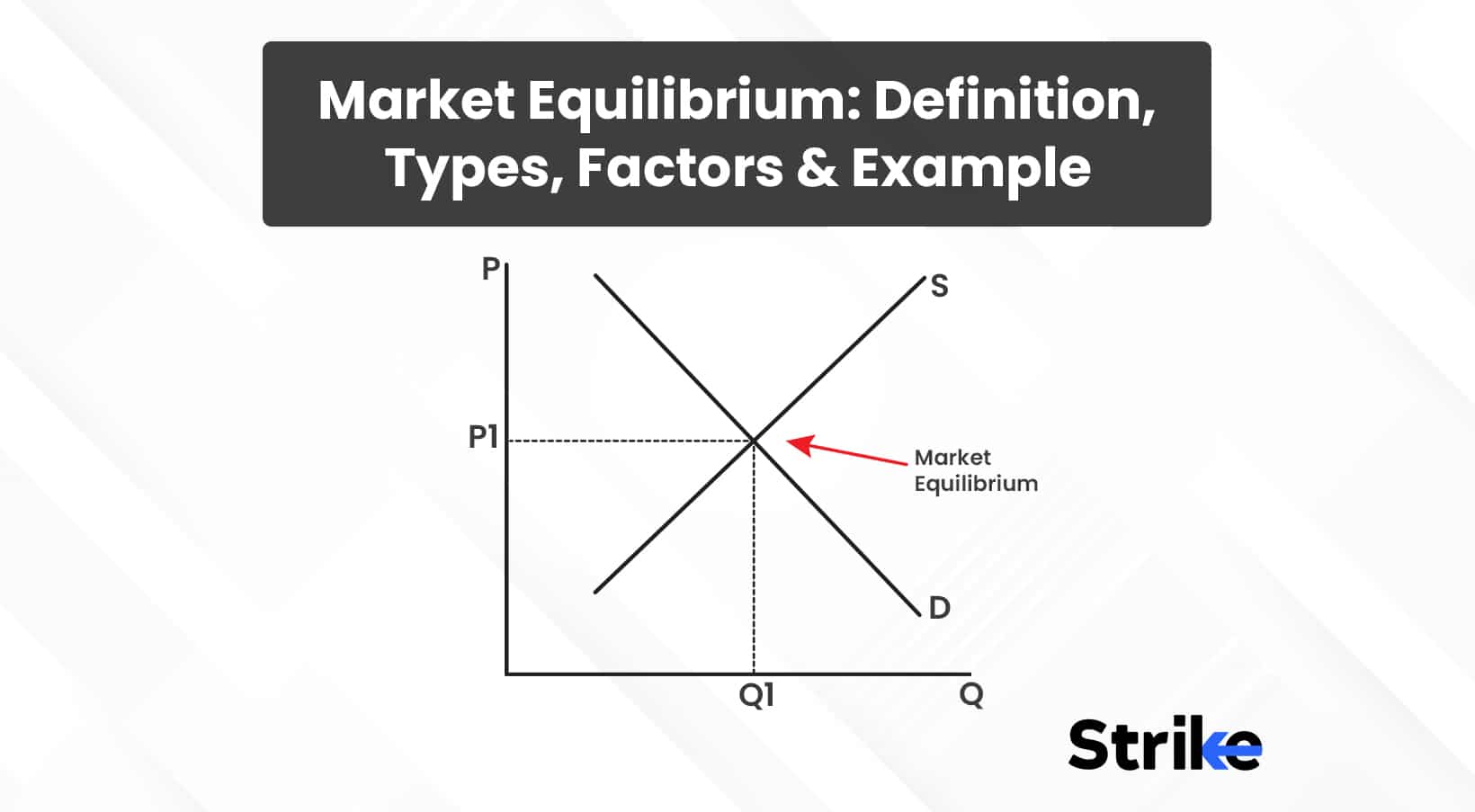
Market equilibrium refers to a stable state in which supply and demand are in balance. Market equilibrium creates the equilibrium price, where the quantity supplied by sellers matches the quantity demanded by buyers. The market reaches a state of rest where there are no inherent pressures for change. There are two types of market equilibrium – equilibrium in a single market which focuses on one good or service, and general equilibrium which refers to equilibrium across multiple markets in an economy.
Factors determine a market’s equilibrium price includes supply and demand, price elasticity, barriers to entry, cost of production, availability of substitutes, overall economy, seasonal factors, speculation, and government intervention.
A simple example of equilibrium price in a single market would be an agricultural good like corn. The price of corn is too high means the quantity supplied will be greater than demand, creating a surplus. This drives the price down. The corn prices are too low means demand will exceed supply resulting in a shortage.
This pushes the price back up. The equilibrium price is where supply and demand balance out and there are no shortages or surpluses. At this stable price, producers are willing to sell and consumers are willing to buy the quantity of corn that matches demand and supply.
What does Market Equilibrium mean?
Market equilibrium is a stable state in a market where the quantities of supply and demand are equal. Market equilibrium occurs at an equilibrium price where the amount that buyers wish to purchase matches the amount that sellers wish to sell. Equilibrium creates a state where there are no inherent market pressures to raise or lower the price.
Market equilibrium results from the forces of supply and demand. The equilibrium price is determined by the intersection of the supply and demand curves. Below is a pictorial representation of the supply and demand curve.

The quantity supplied exceeds demand at a higher price, resulting in a surplus that causes the price to fall. Demand exceeds supply at a lower price, resulting in a shortage that causes the price to rise. The equilibrium price balances these forces at a stable point.
Three characteristics of market equilibrium are equilibrium price, quantity and the absence of shortages and surpluses.
Equilibrium price
The quantity supplied by sellers equals the quantity demanded by buyers at the equilibrium price. Neither buyers nor sellers have an incentive to change from this price.
Equilibrium quantity
The quantity transacted that corresponds to the equilibrium price. Buyers purchase the same amount that sellers provide.
Absence of shortages and surpluses
Since the quantity supplied and demanded are equal, there is no leftover amount or unmet amount. The market clears.
The key factor that determine a market’s equilibrium is cost of production. The lower the cost to produce a good or service, the lower the equilibrium price. Higher costs require higher equilibrium prices to earn a profit. How sensitive consumers are to price changes impacts the equilibrium price as well. For inelastic goods, equilibrium prices remain stable. For elastic goods, small price changes significantly impact the equilibrium.
The difficulty of new suppliers entering a market allows existing suppliers to set higher equilibrium prices, as barriers to entry prevent easy access for new competitors. The market experiences an influx of new entrants, leading to reduced equilibrium prices.
Additionally, the availability of substitutes plays a crucial role in determining the equilibrium price, as markets with close substitutes tend to maintain lower prices, while those with limited alternatives can charge higher amounts. Seasonal factors also impact the equilibrium prices in certain markets, particularly for agricultural goods, as supply and demand change throughout the year.
Economic conditions significantly influence the equilibrium price, with strong economies and high demand driving prices upwards, whereas weak economies often result in lower equilibrium prices.
How does Market Equilibrium function?
Market equilibrium functions through the interaction of supply and demand in a market. The quantity supplied by sellers matches the quantity demanded by buyers at the equilibrium price. The market achieves a stable state where there are no shortages or surpluses and no pressures for the price to rise or fall.
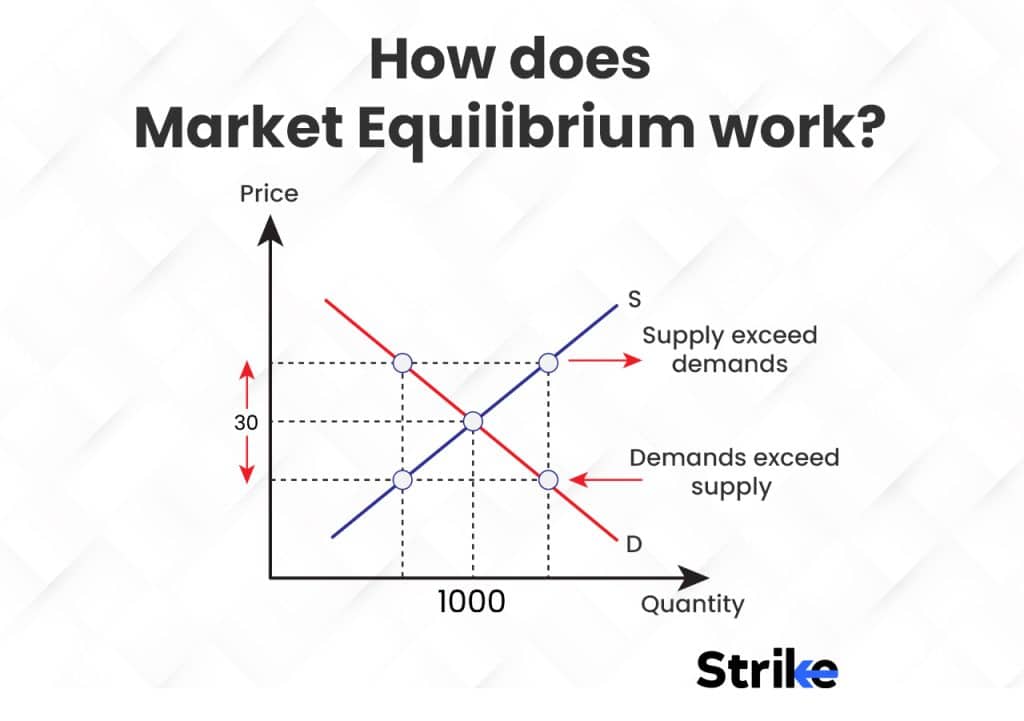
The market equilibrium works when the price is above equilibrium, the quantity supplied exceeds the quantity demanded. This results in a surplus that causes the price to decline. Sellers have to lower their price to sell excess supply. The quantity demanded exceeds the quantity supplied when the price is below equilibrium. This results in a shortage that causes the price to rise.
Buyers have to bid the price up to obtain limited supply. The price continues to fluctuate based on surpluses and shortages until it reaches the equilibrium price where supply and demand are in balance. The market achieves a state of rest with a stable quantity transacted at this price.
Equilibrium price or quantity changes signal a shift in the supply or demand curves due to influencing factors. The market equilibrium re-balances at a new price to clear surpluses or shortages. Equilibrium is a dynamic mechanism that is always seeking stability.
Microeconomists and business analysts pay close attention to market equilibrium, as it plays a crucial role in determining pricing strategies that maximize profitability without resulting in surpluses or shortages. The equilibrium price serves as the focal point in these analyses. Factors such as the sensitivity of demand to price changes, the availability of substitutes, and the elasticity of demand influence equilibrium prices. Equilibrium prices must remain competitive when demand is more elastic, while inelastic demand allows for higher equilibrium prices.
Market entry barriers and the market power of existing suppliers also impact equilibrium price levels. A more accessible market encourages new entrants, which leads to increased competition and lower equilibrium prices. Seasonal shifts in equilibrium quantity and pricing are essential to consider, as they inform tailored production, marketing, and sales strategies based on seasonal demand.
Analyzing the health of a market based on its current equilibrium state is vital. A high quantity and stable equilibrium price may signal a robust market, whereas volatile or declining equilibrium conditions could indicate a weakening market.
What are the 2 types of Market Equilibrium?
Partial and general equilibrium are the two main types of market equilibrium concepts. Below is detailed description about both of them.
1. Partial Equilibrium
Partial equilibrium refers to equilibrium in a single market. Partial equilibrium focuses on the equilibrium price and quantity for one specific good or service. Partial equilibrium analysis assumes that the effect in one market does not significantly impact other markets.
Examples of partial equilibrium are the equilibrium price for oranges, the equilibrium rent for 2-bedroom apartments in a city, and the equilibrium wage for accountants.
Partial equilibrium is important as it helps understand the supply, demand and pricing dynamics in an individual market. Useful for businesses in a specific industry. Allows for tailored strategies around production, marketing and sales.
2. General Equilibrium
General equilibrium refers to equilibrium across multiple interrelated markets in an economy. It focuses on the simultaneous equilibrium of supply and demand in all markets based on linkages between them. Changes in one market influences equilibrium in another.
General equilibrium exists across all agricultural markets, labor markets and manufactured goods markets in an economy. A change in demand for automobiles impacts the equilibrium of auto parts suppliers, steel producers, and related labor markets.
It provides a macro view of how supply, demand and pricing interdependencies coordinate economic activity. Useful for governments in policymaking decisions around regulation, trade agreements, taxes, subsidies, etc. Helps analyze how events like oil shocks, technological changes or global trade pacts impact the broad economy.
Below is a tabular comparison of the both for a better understanding.
| Feature | Partial Equilibrium | General Equilibrium |
| Assumptions | No spillover effects from one market to another | Interdependencies between markets are incorporated |
| Focus | Single price and quantity | Equilibrium across many prices and quantities simultaneously |
| Perspective | Narrow, microeconomic | Broad, macroeconomic |
| Complexity | Simpler with few variables changing | Complex with many markets and variables involved |
| Dynamics | Easier to understand in a single market | Challenging to grasp dynamics across many interconnected markets in an economy |
Both concepts are useful tools for understanding how supply and demand drive the allocation of resources and determine prices in a market-based economy. Partial equilibrium has a micro focus, while general equilibrium takes a macro view. Together, they provide insight into how equilibrium operates at both an individual market level as well as an aggregate economy-wide level
What are the 5 factors affecting Market Equilibrium?
Excess demand or supply, changes in either or both demand and supply, competitive factors and strategic factors are the give main factors that affects the market equilibrium. These factors either present on their own or as a combination. Below is a detailed description.
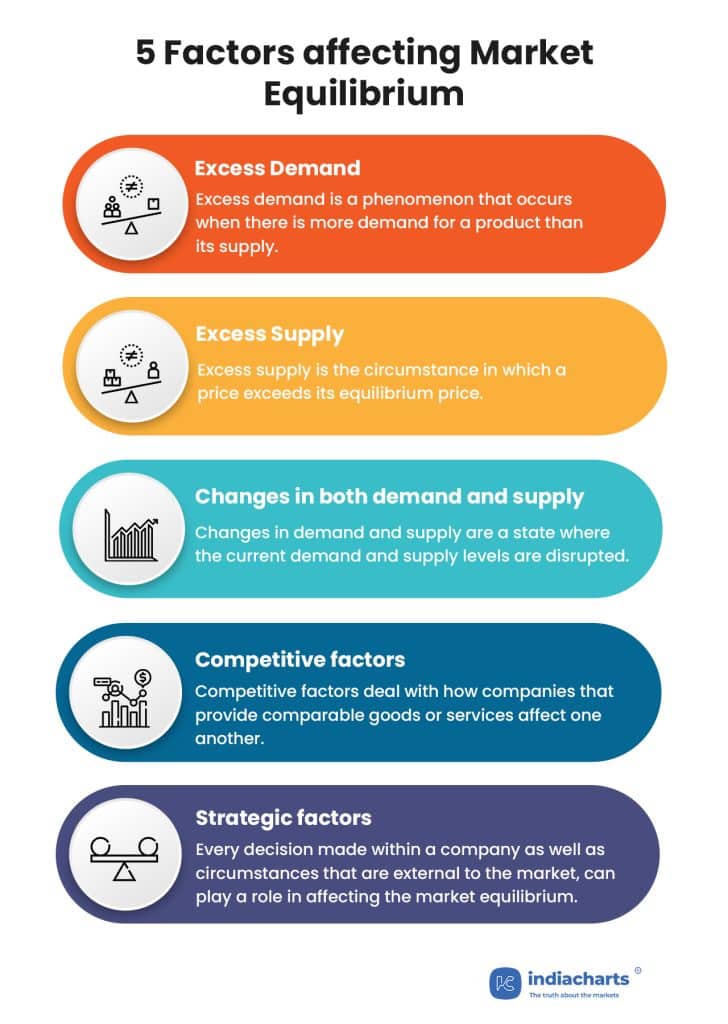
1. Excess Demand
Excess demand occurs when the quantity demanded exceeds the quantity supplied at a given price. An excess demand situation creates upward pressure on the price, as buyers compete to purchase the limited supply of goods or services. Demand decreases as the price increases, and supply increases until the market reaches a new equilibrium point.
2. Excess Supply
Excess supply arises when the quantity supplied exceeds the quantity demanded at a given price. This leads to downward pressure on the price, as sellers compete to sell their goods or services. The demand increases as the price decreases, and supply decreases until a new equilibrium point is established in the market.
3. Changes in both Demand and Supply
Changes in demand and supply occur simultaneously, affecting market equilibrium. An increase in both demand and supply result in a higher equilibrium quantity but an unchanged equilibrium price. A decrease in both demand and supply could lead to a lower equilibrium quantity, with the equilibrium price remaining the same. The overall impact on market equilibrium depends on the relative magnitude of the shifts in demand and supply.
4. Competitive Factors
Competitive factors, such as the entry of new firms, the exit of existing firms, or changes in the intensity of competition among firms, influence market equilibrium. Increased competition generally leads to lower prices and higher quantities, whereas reduced competition may result in higher prices and lower quantities. These changes in the competitive landscape can cause shifts in both supply and demand, ultimately affecting the market equilibrium.
5. Strategic Factors
Strategic factors, such as pricing strategies, product differentiation, and marketing efforts, can impact market equilibrium by influencing firms’ decisions regarding production levels and consumers’ purchasing behaviour. A firm could decide to lower its price to increase market share, leading to a shift in the demand curve for its product. This change in demand affects the overall market equilibrium, as other firms may respond by adjusting their prices or production levels accordingly.
Market equilibrium is an integral component of understanding economic supply and demand dynamics, as it impacts various elements such as excess demand, excess supply, changes in both demand and supply, competitive factors and strategic considerations. Analyzing these elements help macroeconomists, business analysts and other stakeholders make informed decisions regarding production, pricing and resource allocation decisions.
A well-functioning market with an efficient equilibrium can promote economic growth by offering price stability as well as optimal resource allocation; knowing how these influences interact is the key to creating a healthy economy.
What are examples of Market Equilibrium in the stock market?
IPO equilibrium and trading equilirubim are two examples of market equilibrium. IPO equilibrium is when a company first lists its shares on the stock market through an initial public offering or IPO, the issuing price is set based on estimated demand from investors and the supply of new shares. A high price means investors will demand fewer shares resulting in excess supply.
A price too low means investor demand will be much higher than available shares resulting in excess demand. The equilibrium IPO price balances this by matching the supply of new shares and demand from investors to fully subscribe the offering.
Trading equilibrium happens once shares are listed, the market price of the stock fluctuates based on continuous buying and selling. Seller supply exceeds buyer demand resulting in a surplus that brings the price back down when the price rises above the equilibrium trading price.
Buyer demand exceeds seller supply resulting in a shortage that bids the price back up when the price rises above the equilibrium trading price. The equilibrium trading price represents the midpoint where buyers and sellers are satisfied and supply consistently matches demand with normal market activity and volume.
How do supply and demand relate to Market Equilibrium?
Supply refers to the quantity of a good or service that producers are willing and able to sell at a given price. Demand refers to the quantity that consumers are willing and able to buy at a given price. Market equilibrium is reached as a result of the balanced impact of supply and demand.
At the equilibrium price, the quantity supplied by producers equals the quantity demanded by consumers. This results in a stable market price and quantity where there are no shortages or surpluses. Supply and demand determine equilibrium in three steps.
- The price exceeds the equilibrium level (demand greater than supply), and results in excess demand causing upward pressure on the price. The price rises until it reaches the equilibrium point where demand equals supply.
- The price falls below the equilibrium level (supply greater than demand), and it results in excess supply putting downward pressure on the price. The price declines until it reaches equilibrium where supply matches demand.
- The supply or demand curves shift due to a change in the influencing factors, and the old equilibrium cannot be sustained. A new equilibrium price and quantity emerge at the level where the new supply and new demand curves intersect.
- At equilibrium, there is no tendency for the price to either rise or fall indicating stable market conditions. There are no unmet shortages or leftover surpluses as the total amount supplied clears the total amount demanded.
- Equilibrium indicates an optimal efficiency in the market with scarce resources allocated to their most valued uses. Welfare is maximized for both consumers and producers at the equilibrium price and quantity.
The equilibrium model relies on a flexible, competitive market structure where many small suppliers and demanders determine equilibrium based on their individual choices and perceived self-interest. If large suppliers or demanders dominate they manipulate the equilibrium price. Government intervention also impacts how efficiently equilibrium is reached based on policies around price controls, taxes, subsidies, trade barriers, etc.
What is Market Equilibrium formula?
The formula for calculating market equilibrium is Quantity Supplied (QS) = Quantity Demanded (QD)
This means the amount of a good or service that producers are willing to sell at a given price equals the amount that consumers are willing to buy at that same price. The opposing forces of supply and demand are in balance at equilibrium.
To determine equilibrium, you must know the following
The supply curve

This shows how much producers will supply at each possible price level, all else being equal. The supply curve slopes upward indicating that a higher price motivates more supply.
The demand curve

This shows how much consumers will demand at each possible price level, all else being equal. The demand curve slopes downward indicating that a lower price spurs more demand.
Find the intersection of the supply and demand curves

The equilibrium price is located where the supply and demand curves cross. At any other price besides the equilibrium, supply and demand are out of balance.
The equilibrium quantity
This is located on the horizontal axis below the equilibrium price. It indicates the total amount that is both supplied by producers and demanded by consumers at the equilibrium price.
The second-order formula relates the degree of imbalance when the market price deviates from equilibrium.
Disequilibrium = |QS − QD|
Where |QS − QD| refers to the absolute value of the difference between quantity supplied and quantity demanded at a given price. The greater this value, the further the market is from equilibrium. At equilibrium, this value equals zero since there is no difference between quantity supplied and demanded.
In a formula, equilibrium means
P* and Q* (equilibrium price and quantity)
Such that QS(P*) = QD(P*)
Disequilibrium (P*) = 0
Where P* is the price that balances the equality between quantity supplied and quantity demanded at Q*. At the equilibrium price, the desires and interests of both producers and consumers are optimized. There are no unfulfilled shortages or wasteful surpluses.
The equilibrium formula is a mathematical representation of how free market forces determine optimal pricing and resource allocation. The equilibrium model applies to both individual product markets as well as factor markets for inputs like labour, capital, land, and raw materials.
Equilibrium is a theoretical ideal representing a perfectly competitive market. In reality, imperfections exist but the equilibrium formula provides a framework for analyzing supply, demand, and pricing dynamics in a market economy.
How can we calculate Market Equilibrium?
Market equilibrium is calculated using the following formula Quantity Supplied (QS) = Quantity Demanded (QD). This means at the equilibrium price (P*), the amount producers are willing to supply equals the amount consumers are willing to demand. Let us look at an example of how to calculate market equilibrium.
Suppose the supply and demand curves for corn are
Supply: QS = 10 + 2P (P represents Price)
Demand: QD = 40 – 3P
Set QS equal to QD and solve for P:
QS = QD
10 + 2P = 40 – 3P
4P = 30
P = 7.5
So the equilibrium price (P*) is Rs.7.50
Substitute the equilibrium price into either the supply or demand curve to get the equilibrium quantity (Q*):
QS = 10 + 2(7.5) = 10 + 15 = 25
So at a price of Rs.7.50, the equilibrium quantity (Q*) supplied and demanded is 25 units.
Check if QS = QD at the equilibrium price:
QS (P* = 7.5) = 25
QD (P* = 7.5) = 40 – 3(7.5) = 40 – 22.5 = 25
Therefore, QS does equal QD at the equilibrium price of Rs.7.50.
At a price below Rs.7.50, QD > QS resulting in excess demand and upward pressure on the price.At a price above Rs.7.50, QS > QD resulting in excess supply and downward pressure on the price. Only at the equilibrium price of Rs.7.50 with a quantity of 25 units are the interests of both producers and consumers optimized as supply matches demand.
The supply or demand curve shifts due to a change in factors like costs, technology, needs or tastes, causes a new equilibrium to emerge at the price where the new QS = new QD. Equilibrium is dynamic.
The equilibrium model works for individual product markets as well as factor markets for inputs like labour, capital, land, and raw materials. It provides a framework for how a competitive market determines optimal pricing and resource allocation through the balancing forces of supply and demand.
How to read Market Equilibrium graph?
Market equilibrium can be shown graphically using supply and demand curves. Below is a supply and demand graph.

The supply curve shows the quantity of a good that producers are willing to supply at each possible price level, all else being equal. The supply curve slopes upward indicating that a higher price leads to a greater quantity supplied. The demand curve shows the quantity that consumers are willing to demand at each possible price level, all else being equal. The demand curve slopes downward indicating that a lower price boosts the quantity demanded.
The equilibrium point is located where the supply and demand curves intersect. The equilibrium price is found on the vertical axis, with the equilibrium quantity located on the horizontal axis, at the point below where the curves cross. At the equilibrium price, the quantity supplied by producers equals the quantity demanded by consumers, meaning supply matches demand.
There are no shortages or surpluses. A price is above equilibrium signifies quantity supplied will exceed quantity demanded resulting in excess supply. This imbalance causes downward pressure on the price, as producers try to clear excess inventory. The price will fall until it returns to the equilibrium point where supply once again matches demand.
The price falls below equilibrium signifies quantity demanded will exceed quantity supplied creating excess demand. This prompts the price to rise as consumers compete to obtain scarce supply. The price climbs until equilibrium is restored where demand corresponds with supply.
At the equilibrium price, the interests of both producers and consumers are optimized. Both are transacting the quantity they intend to produce or consume given the price level. There is no incentive for further upward or downward price pressure.
The equilibrium price represents an stable point of rest in the dynamic market system Equilibrium will change to the new price point where the supply and demand curves intersect if supply or demand shifts due to a change in costs, tastes or other factors.
The equilibrium model applies to both individual product markets as well as factor markets for inputs used in the production process. Equilibrium shows how a competitive market’s pricing mechanism allocates resources to their optimal usage based on the interaction between producers and consumers seeking to fulfill their own needs and wants.
Though theoretical, the equilibrium concept provides a framework for understanding how markets reach a stable state through the equalizing forces of supply and demand, and how equilibrium changes in response to influences that shift these curves outward or inward.
What are the advantages of Market Equilibrium in the stock market?
The main advantage of market equilibrium is that it leads to efficient allocation of resources. Below are five main disadvantages.
Allocation of resources
Market equilibrium ensures an efficient allocation of resources. Buyers and sellers agree on a price which provides no surplus or shortage of available resources; at this price all available resources are being utilized fully.
Fairness
Market equilibrium is generally considered fair as it represents both buyers and sellers’ preferences equally. Both parties are willing to accept that neither side is getting more advantageous terms than the other party.
Stability
Market equilibrium is a stable state. Once it reaches equilibrium, it will not likely shift apart from an increase or decrease in supply or demand and both buyers and sellers have incentives to maintain equilibrium prices and prices should remain constant over time.
Innovation
Market equilibrium leads to innovation. Firms seek ways to enhance them and discover ways to innovate new ones for consumers’ benefit when competing firms strive to sell their products or services. This results in innovation.
Consumer Surplus
Market equilibrium leads to consumer surplus. This is defined as the difference between the amount consumers are willing to pay and what they actually have to pay – it measures the benefit that market provides to its participants.
Market equilibrium leads to efficient allocation of resources, fairness, stability, innovation, and consumer surplus. These advantages are why market equilibrium is considered to be an important concept in economics.
What are the disadvantages of Market Equilibrium in the stock market?
Market equilibrium causes inefficiencies and it is often considered the main disadvantages of the same. Below are the four main disadvantages.
Market Inefficiency
Market equilibrium is not always optimal due to public goods and externalities that cannot be traded in markets; for instance, clean air prices do not provide an incentive for people to reduce pollution despite benefiting society as a whole.
Market Equilibrium and Inequality
Market equilibrium creates inequality because its price reflects buyers and sellers’ preferences; however, not everyone shares these same preferences, meaning some individuals fare worse off at equilibrium than others – food costs are high means people living on limited resources not be able to purchase enough meals at this time to meet their nutritional requirements.
Market Instability
Market equilibrium tend to be tenuous due to fluctuations in supply or demand affecting price at equilibrium. For instance, sudden increases in demand force prices above equilibrium leading to shortages that cause problems for both consumers and businesses alike.
Externalities
Market equilibrium does not take into account externalities, which are costs or benefits not borne directly by producers and consumers of a good or service. Pollution, for example, imposes costs upon people unrelated to its production or consumption – which market equilibrium fails to take into account. As a result, too much pollution be produced.
market equilibrium has some disadvantages. It may lead to inefficiency, inequality, instability, and externalities. These disadvantages are why market equilibrium is not always considered to be the best way to allocate resources.
What is Equilibrium price?
Equilibrium price refers to the stable price point in a market where quantity supplied equals quantity demanded. At the equilibrium price, the interests of both buyers and sellers are optimized. The equilibrium price is determined by the intersection of the market supply and demand curves. Quantity supplied exceeds quantity demanded resulting in a surplus at equilibrium.
This drives the price down. Price below equilibrium indicates quantity demanded exceeds quantity supplied resulting in a shortage. This causes the price to rise. The equilibrium price is where these opposing forces balance out at a level that clears the market, with supply matching demand.
What the equilibrium price means there is no excess supply or demand. The total amount producers wish to sell exactly matches the total amount consumers wish to buy. All available supply is able to satisfy demand. The equilibrium price also represents a steady state where there are no forces acting to raise or lower the price.
Both buyers and sellers are content to continue transacting at this stable price level. The gains from trade are maximized as resources are allocated to their most valued uses based on the preferences of both buyers and sellers. Welfare is optimized for all participants.
Equilibrium is a temporary rest point. Changes in factors like costs, incomes, tastes or technology will shift the supply or demand curves, disrupting the old equilibrium. A new equilibrium price must be established where the new supply and demand levels intersect.
Equilibrium is constantly evolving. The equilibrium model assumes perfectly competitive supply and demand conditions. In reality, market imperfections prevent equilibrium from being reached or cause the equilibrium price to differ from the optimal level that maximizes welfare. Equilibrium is an idealized concept that provides a reference point for analyzing real-world markets.
How to Determine Equilibrium price?
The market supply curve represents the quantity supplied by producers at each possible price level, while holding other factors constant. It slopes upward, indicating that a higher price leads to a greater quantity supplied as producers find it more profitable.
The market demand curve shows the quantity demanded by consumers at each possible price level, with other factors held constant. This curve slopes downward, as a lower price results in a higher quantity demanded, making the good or service more affordable for consumers.
Equilibrium is reached when the supply and demand curves intersect, resulting in an equilibrium price. This price balances the market, where quantity supplied exactly matches quantity demanded, with no surpluses or shortages and no inherent tendency to change.
The equilibrium quantity, found on the horizontal axis below the equilibrium price, represents the total amount supplied by producers that exactly satisfies the total amount consumers wish to purchase.
It is clear that only at the equilibrium price are supply and demand balanced. When the price is above equilibrium, quantity supplied exceeds quantity demanded, resulting in excess supply. Conversely, when the price is below equilibrium, quantity demanded exceeds quantity supplied, causing excess demand. The equilibrium price (P*) is found when Supply (Qs) equals Demand (Qd) at (P*). The equilibrium quantity (Q*) can then be determined by plugging the equilibrium price into either the supply or demand curve equation.
In a competitive market system, the equilibrium price results from the interaction of supply and demand. It reflects the point where both producer and consumer interests are optimized, given available resources and the current economic environment.
The equilibrium price mechanism is vital for determining how resources are allocated to different uses based on where supply and demand meet. Though a theoretical ideal, finding equilibrium in imperfect real-world markets is still the goal for determining optimal pricing and welfare gains from exchange.
How often Market Equilibrium happen?
Market equilibrium is often considered a theoretical ideal that is continuously pursued but rarely achieved for extended periods in reality.
One factor that contribute to markets’ inability to reach or maintain perfect equilibrium is the constant change in the elements that influence supply and demand. These elements include costs of production, technological advancements, consumer incomes and preferences, prices of substitute and complementary products, seasonal impacts, and overall economic conditions.
A shift cause the supply and demand curves to change, disrupting any existing equilibrium and necessitating the emergence of a new equilibrium price and quantity. Equilibrium is only temporary as a result.
Imperfect competition also prevents markets from achieving equilibrium. The equilibrium model assumes numerous small buyers and sellers, perfect information, and easy entry and exit. However, in real markets, imperfect competition arises due to the presence of large suppliers or buyers, barriers to entry, lack of transparency, and product differentiation. Market power allows for the manipulation of prices away from the optimal level that would maximize welfare at the intersection of supply and demand.
Another factor that hinders market equilibrium is the role of expectations and speculation. The equilibrium price depends on the current levels of supply and demand, but trading also relies on expectations about future changes in supply, demand, or market events that may impact equilibrium. Such expectations often lead to speculation, which distorts the current equilibrium. Expectations change or prove incorrect indicates speculation subsides, and equilibrium must be rebalanced.
Government intervention also affects market equilibrium. Public policies like price controls, taxes, subsidies, trade barriers, or regulations aim to influence the equilibrium price and quantity in line with social objectives. These policies may prevent equilibrium or reduce welfare by distorting the natural functioning of supply and demand. Government intervention can create secondary inefficiencies that equilibrium would otherwise optimize.
Price stickiness also prevents markets from reaching equilibrium. The equilibrium price should adjust freely based on market forces. But in reality, prices tend to be “sticky” due to various frictions such as contracts, cultural norms, or menu costs that prevent instantaneous price changes. Markets remain in disequilibrium until the new equilibrium price emerge and guide supply and demand. Consequently, real-world prices do not always move flexibly toward equilibrium.
What is it called when a Market is not in Equilibrium?
A market is said to be in a state of ‘disequilibrium’ when it is not in equilibrium. The quantity demanded does not equal the quantity supplied in this state. This leads to market imbalances. This situation usually occurs due to reasons, such as changing in the overall market conditions, government interventions, or external shocks.
There are two primary types of disequilibrium. Equilibrium is made possible when both supply and demand are equal. Hence, the two types of market disequilibrium is caused by excess demand and excess supply.
- Excess demand
This occurs when the quantity demanded exceeds the quantity supplied at a given price. In this situation, buyers are willing to purchase more goods than sellers are willing to produce, resulting in a shortage. Excess demand often leads to an increase in price, as consumers compete for the limited supply of goods.
- Excess supply
This occurs when the quantity supplied exceeds the quantity demanded at a given price. In this situation, sellers are willing to produce more goods than buyers are willing to purchase, resulting in a surplus. Excess supply often leads to a decrease in price, as producers compete to sell their goods.
The forces of supply and demand will eventually push the market back toward equilibrium in a healthy and in a competitive market . Excess demand will cause a situation where the prices will rise, and suppliers will increase their production in response to higher profits.
This increase in supply will eventually bring the market back to equilibrium. Conversely, when there is excess supply, prices will fall, and suppliers will reduce their production in response to lower profits. This reduction in supply will ultimately bring the market back to equilibrium. But these adjustments not always occur quickly or smoothly. Factors such as market imperfections, government interventions, or external shocks can delay or hinder the adjustment process.
Disequilibrium often has significant consequences for an economy. In the short term, excess demand can lead to inflationary pressures, as higher prices reduce the purchasing power of consumers. On the other hand, excess supply can lead to deflationary pressures, as lower prices reduce the profitability of businesses and result in layoffs and reduced investment.
In the long term, persistent disequilibrium could result in resource misallocation and reduced economic growth. For example, prolonged excess demand can lead to the overallocation of resources to a specific sector, causing a boom-and-bust cycle. In contrast, prolonged excess supply can result in underinvestment in a sector, causing potential long-term economic stagnation.
Are Markets always in Equilibrium?
No, markets are not always in equilibrium. Market equilibrium is an ideal state where the quantity demanded equals the quantity supplied, resulting in a stable market price. But in reality, markets are often in a state of disequilibrium due to various factors, such as changing market conditions, government interventions, external shocks, and market imperfections.
What is the difference between Equilibrium and Disequilibrium?
Market equilibrium is an ideal state where the quantity demanded equals the quantity supplied, resulting in a stable market price. Disequilibrium, on the other hand, occurs when the quantity demanded does not equal the quantity supplied, leading to market imbalances and potential price adjustments. Below are more differences between them.
| Feature | Equilibrium | Disequilibrium |
| Quantity supplied | Equals quantity demanded | Does not equal quantity demanded |
| Prices | Stable | Unstable |
| Shortages or surpluses | None | Present |
| Resource allocation | Efficient | Inefficient |
| Buyer and seller satisfaction | Both satisfied | One or both dissatisfied |
| Tendency to change | Tends to remain constant | Tends to change |
| Causes | Changes in supply or demand | Changes in supply or demand, government intervention, market failures |
| Effects | Prices adjust until equilibrium is reached | Prices adjust until disequilibrium is resolved |
| Examples | A perfectly competitive market | A market with a monopoly |




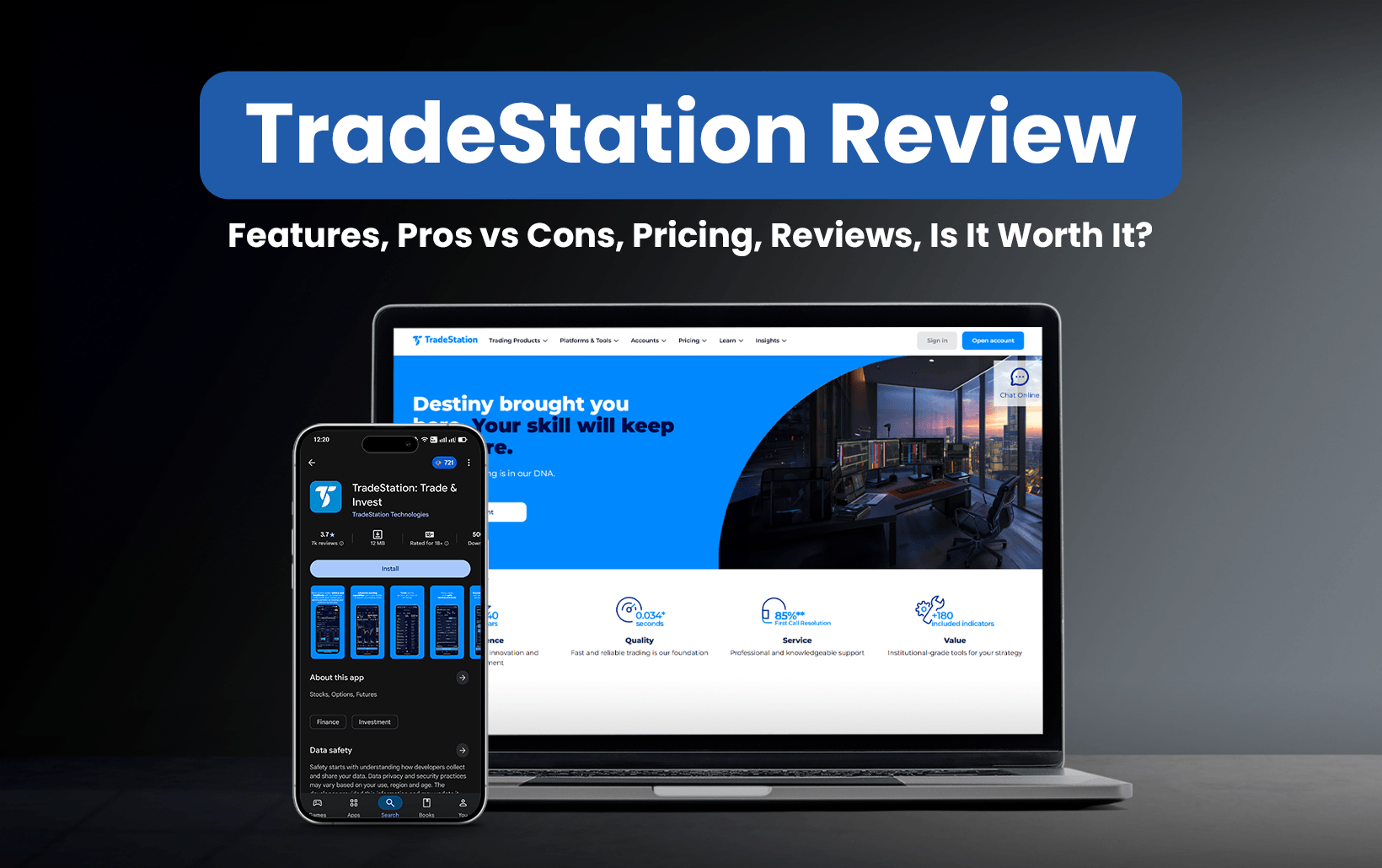
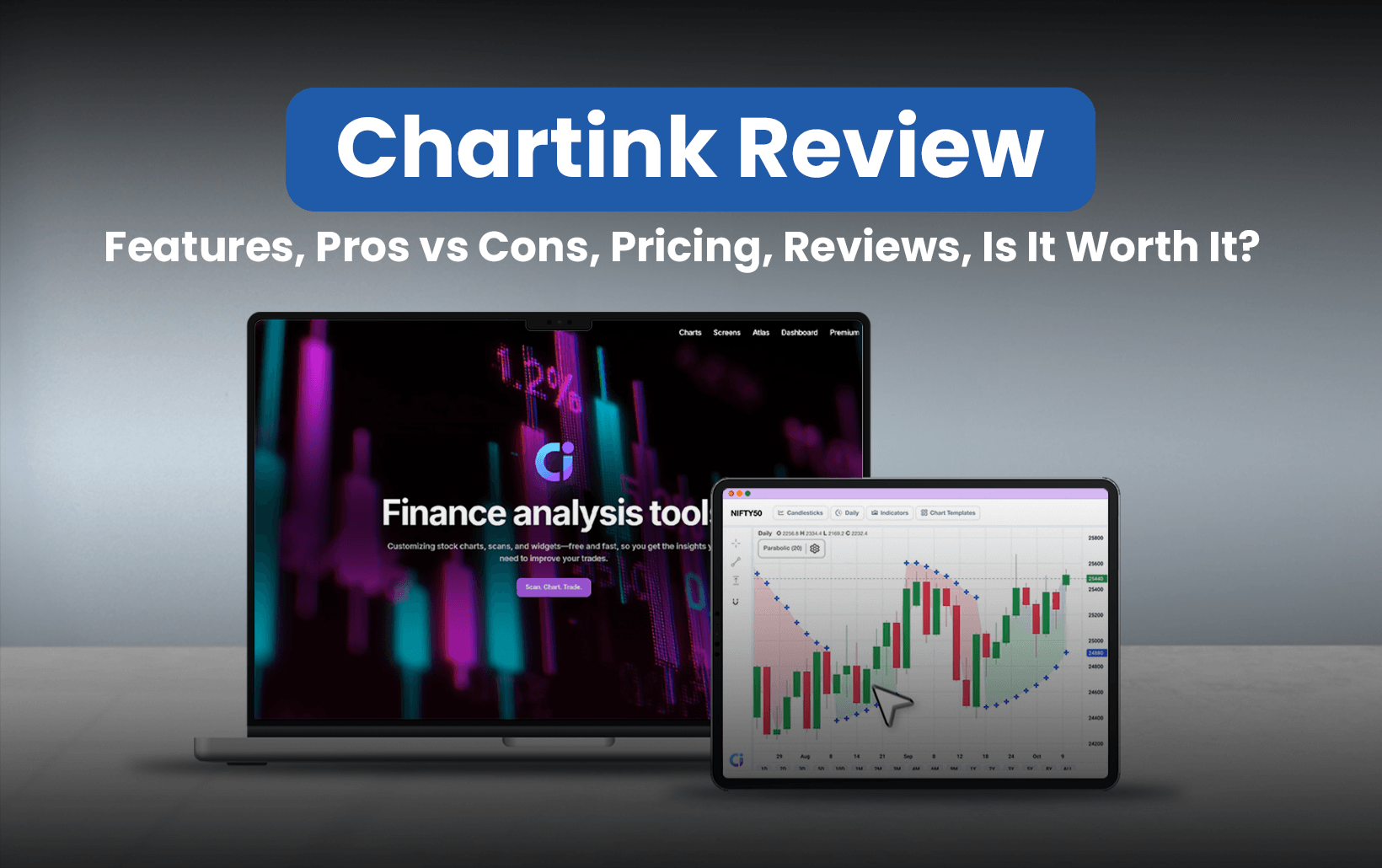
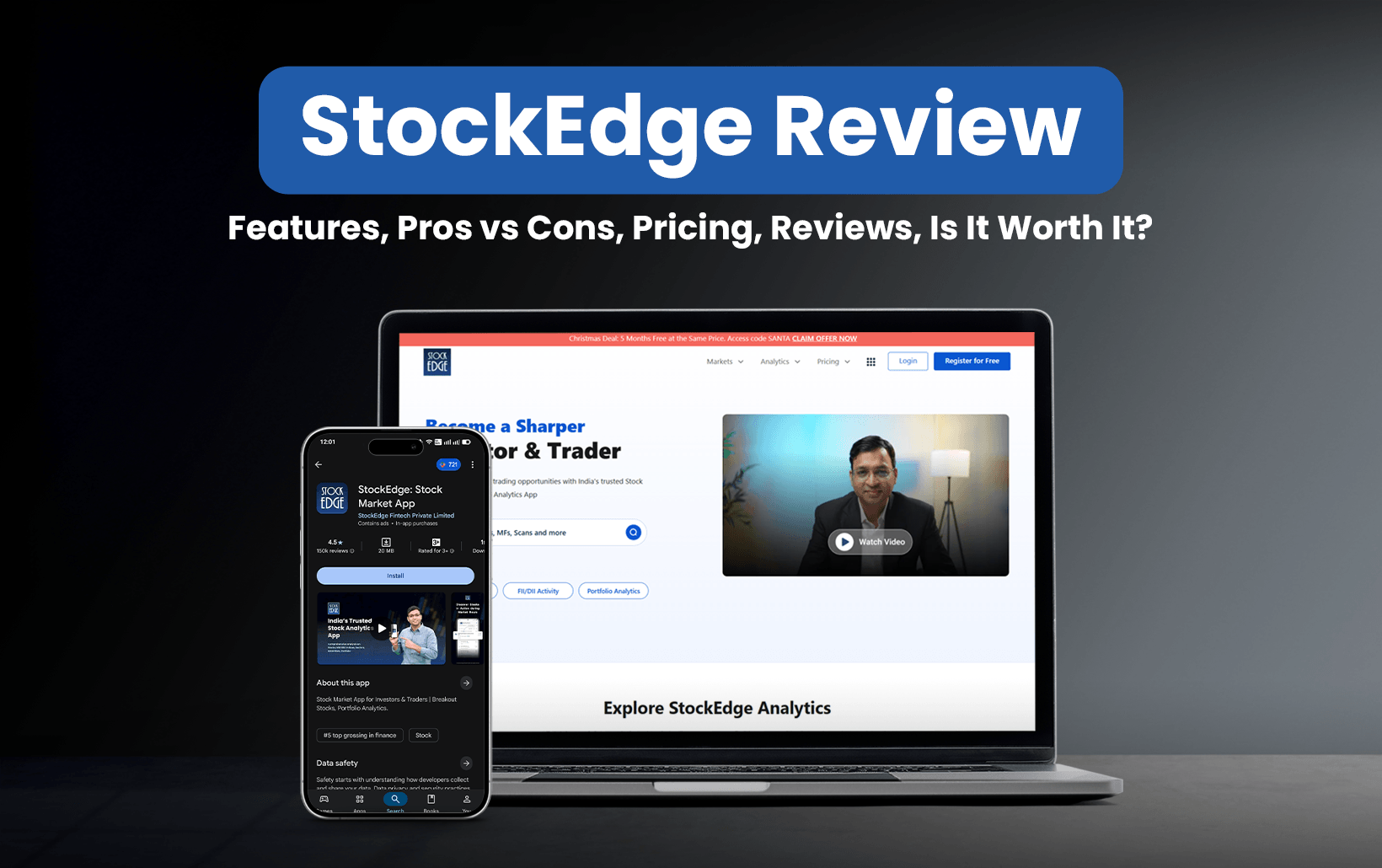
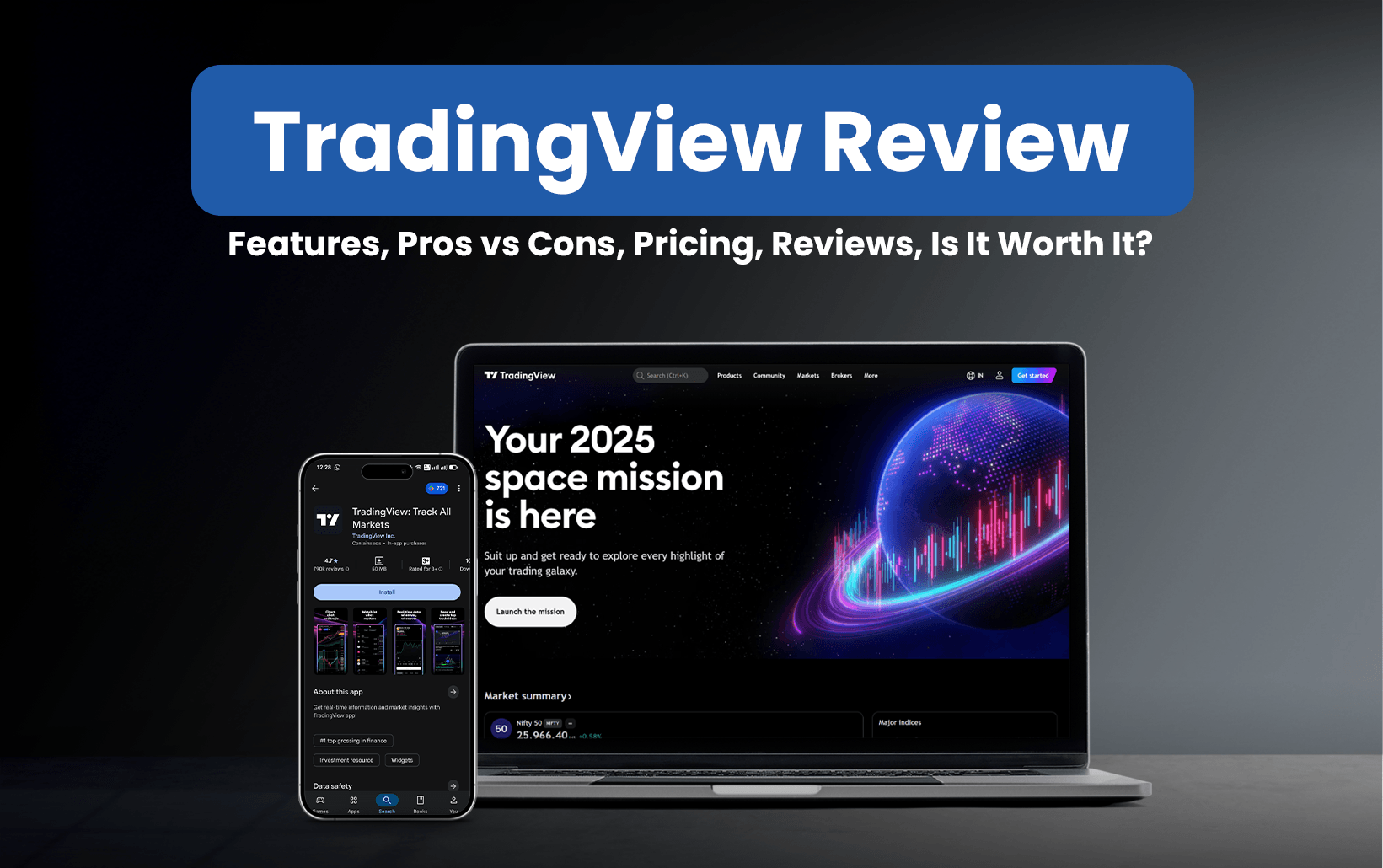

![85 Common Stock Market Terminologies for Dummies [Updated List for 2026] 22 85 Common Stock Market Terminologies for Dummies [Updated List for 2025]](https://www.strike.money/wp-content/uploads/2025/04/Popular-Stock-Market-Terms-for-Beginners-Banner.png)




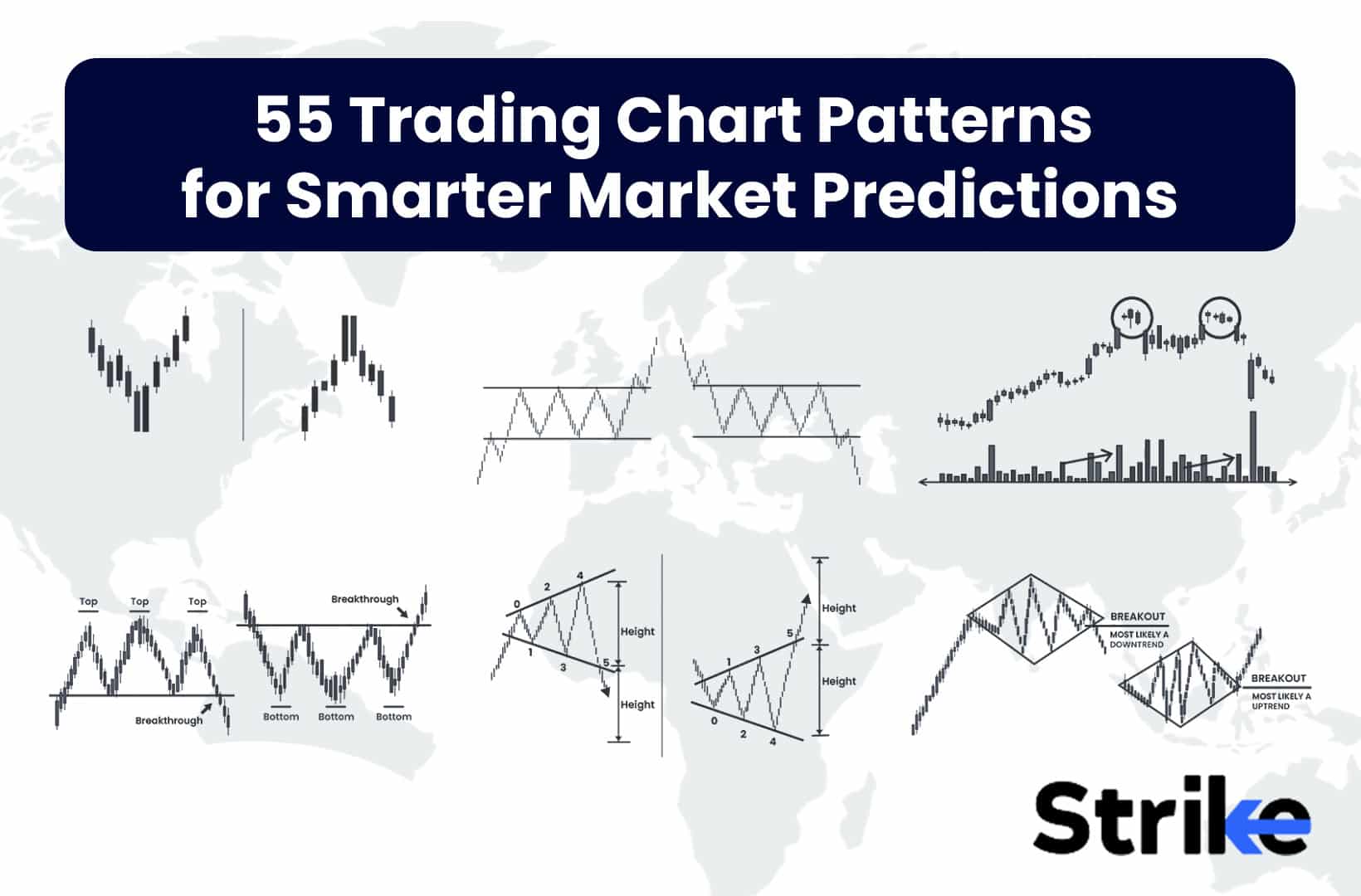





No Comments Yet.